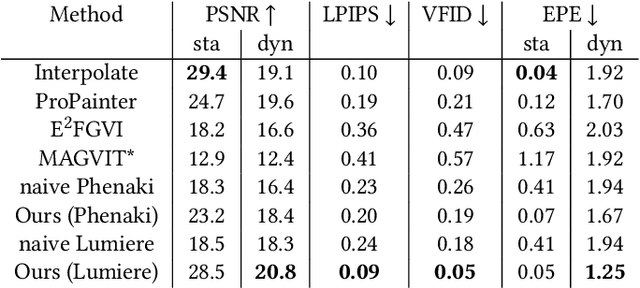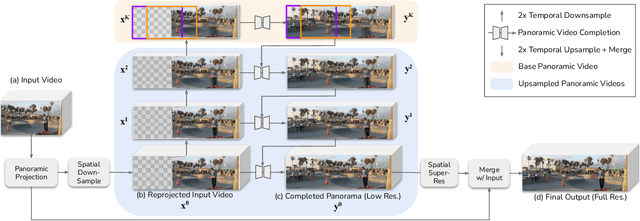Brian Curless
View2CAD: Reconstructing View-Centric CAD Models from Single RGB-D Scans
Apr 05, 2025Abstract:Parametric CAD models, represented as Boundary Representations (B-reps), are foundational to modern design and manufacturing workflows, offering the precision and topological breakdown required for downstream tasks such as analysis, editing, and fabrication. However, B-Reps are often inaccessible due to conversion to more standardized, less expressive geometry formats. Existing methods to recover B-Reps from measured data require complete, noise-free 3D data, which are laborious to obtain. We alleviate this difficulty by enabling the precise reconstruction of CAD shapes from a single RGB-D image. We propose a method that addresses the challenge of reconstructing only the observed geometry from a single view. To allow for these partial observations, and to avoid hallucinating incorrect geometry, we introduce a novel view-centric B-rep (VB-Rep) representation, which incorporates structures to handle visibility limits and encode geometric uncertainty. We combine panoptic image segmentation with iterative geometric optimization to refine and improve the reconstruction process. Our results demonstrate high-quality reconstruction on synthetic and real RGB-D data, showing that our method can bridge the reality gap.
MusicInfuser: Making Video Diffusion Listen and Dance
Mar 18, 2025Abstract:We introduce MusicInfuser, an approach for generating high-quality dance videos that are synchronized to a specified music track. Rather than attempting to design and train a new multimodal audio-video model, we show how existing video diffusion models can be adapted to align with musical inputs by introducing lightweight music-video cross-attention and a low-rank adapter. Unlike prior work requiring motion capture data, our approach fine-tunes only on dance videos. MusicInfuser achieves high-quality music-driven video generation while preserving the flexibility and generative capabilities of the underlying models. We introduce an evaluation framework using Video-LLMs to assess multiple dimensions of dance generation quality. The project page and code are available at https://susunghong.github.io/MusicInfuser.
VidPanos: Generative Panoramic Videos from Casual Panning Videos
Oct 17, 2024



Abstract:Panoramic image stitching provides a unified, wide-angle view of a scene that extends beyond the camera's field of view. Stitching frames of a panning video into a panoramic photograph is a well-understood problem for stationary scenes, but when objects are moving, a still panorama cannot capture the scene. We present a method for synthesizing a panoramic video from a casually-captured panning video, as if the original video were captured with a wide-angle camera. We pose panorama synthesis as a space-time outpainting problem, where we aim to create a full panoramic video of the same length as the input video. Consistent completion of the space-time volume requires a powerful, realistic prior over video content and motion, for which we adapt generative video models. Existing generative models do not, however, immediately extend to panorama completion, as we show. We instead apply video generation as a component of our panorama synthesis system, and demonstrate how to exploit the strengths of the models while minimizing their limitations. Our system can create video panoramas for a range of in-the-wild scenes including people, vehicles, and flowing water, as well as stationary background features.
Inverse Painting: Reconstructing The Painting Process
Sep 30, 2024



Abstract:Given an input painting, we reconstruct a time-lapse video of how it may have been painted. We formulate this as an autoregressive image generation problem, in which an initially blank "canvas" is iteratively updated. The model learns from real artists by training on many painting videos. Our approach incorporates text and region understanding to define a set of painting "instructions" and updates the canvas with a novel diffusion-based renderer. The method extrapolates beyond the limited, acrylic style paintings on which it has been trained, showing plausible results for a wide range of artistic styles and genres.
Generative Inbetweening: Adapting Image-to-Video Models for Keyframe Interpolation
Aug 27, 2024Abstract:We present a method for generating video sequences with coherent motion between a pair of input key frames. We adapt a pretrained large-scale image-to-video diffusion model (originally trained to generate videos moving forward in time from a single input image) for key frame interpolation, i.e., to produce a video in between two input frames. We accomplish this adaptation through a lightweight fine-tuning technique that produces a version of the model that instead predicts videos moving backwards in time from a single input image. This model (along with the original forward-moving model) is subsequently used in a dual-directional diffusion sampling process that combines the overlapping model estimates starting from each of the two keyframes. Our experiments show that our method outperforms both existing diffusion-based methods and traditional frame interpolation techniques.
Don't Look at the Camera: Achieving Perceived Eye Contact
Apr 26, 2024



Abstract:We consider the question of how to best achieve the perception of eye contact when a person is captured by camera and then rendered on a 2D display. For single subjects photographed by a camera, conventional wisdom tells us that looking directly into the camera achieves eye contact. Through empirical user studies, we show that it is instead preferable to {\em look just below the camera lens}. We quantitatively assess where subjects should direct their gaze relative to a camera lens to optimize the perception that they are making eye contact.
Generative Powers of Ten
Dec 04, 2023Abstract:We present a method that uses a text-to-image model to generate consistent content across multiple image scales, enabling extreme semantic zooms into a scene, e.g., ranging from a wide-angle landscape view of a forest to a macro shot of an insect sitting on one of the tree branches. We achieve this through a joint multi-scale diffusion sampling approach that encourages consistency across different scales while preserving the integrity of each individual sampling process. Since each generated scale is guided by a different text prompt, our method enables deeper levels of zoom than traditional super-resolution methods that may struggle to create new contextual structure at vastly different scales. We compare our method qualitatively with alternative techniques in image super-resolution and outpainting, and show that our method is most effective at generating consistent multi-scale content.
Animating Street View
Oct 12, 2023Abstract:We present a system that automatically brings street view imagery to life by populating it with naturally behaving, animated pedestrians and vehicles. Our approach is to remove existing people and vehicles from the input image, insert moving objects with proper scale, angle, motion, and appearance, plan paths and traffic behavior, as well as render the scene with plausible occlusion and shadowing effects. The system achieves these by reconstructing the still image street scene, simulating crowd behavior, and rendering with consistent lighting, visibility, occlusions, and shadows. We demonstrate results on a diverse range of street scenes including regular still images and panoramas.
Total Selfie: Generating Full-Body Selfies
Aug 28, 2023



Abstract:We present a method to generate full-body selfies -- photos that you take of yourself, but capturing your whole body as if someone else took the photo of you from a few feet away. Our approach takes as input a pre-captured video of your body, a target pose photo, and a selfie + background pair for each location. We introduce a novel diffusion-based approach to combine all of this information into high quality, well-composed photos of you with the desired pose and background.
Controllable Light Diffusion for Portraits
May 08, 2023



Abstract:We introduce light diffusion, a novel method to improve lighting in portraits, softening harsh shadows and specular highlights while preserving overall scene illumination. Inspired by professional photographers' diffusers and scrims, our method softens lighting given only a single portrait photo. Previous portrait relighting approaches focus on changing the entire lighting environment, removing shadows (ignoring strong specular highlights), or removing shading entirely. In contrast, we propose a learning based method that allows us to control the amount of light diffusion and apply it on in-the-wild portraits. Additionally, we design a method to synthetically generate plausible external shadows with sub-surface scattering effects while conforming to the shape of the subject's face. Finally, we show how our approach can increase the robustness of higher level vision applications, such as albedo estimation, geometry estimation and semantic segmentation.
 Add to Chrome
Add to Chrome Add to Firefox
Add to Firefox Add to Edge
Add to Edge